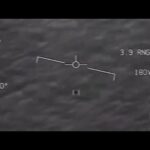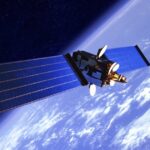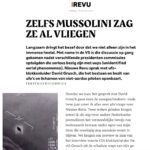
[https://preview.redd.it/ozjwjy5xveab1.jpg?width=2340&format=pjpg&auto=webp&v=enabled&s=e589070cb7234c34210461525dc7912cacef340a](https://preview.redd.it/ozjwjy5xveab1.jpg?width=2340&format=pjpg&auto=webp&v=enabled&s=e589070cb7234c34210461525dc7912cacef340a) Источник: [https://airandspace.si.edu/multimedia-gallery/5311hjpg](https://airandspace.si.edu/multimedia-gallery/5311hjpg) Нашел это на 4chan. по анониму. Увеличьте изображение справа, прямо над горным хребтом. Три синих огня можно увидеть с яркостью по умолчанию. Увеличение светового баланса фотографии делает свет безошибочным. Обсуждалось ли это раньше? Действительно ли фотодоказательства просто прячутся у всех на виду? Забавный факт: если увеличить световой баланс картинки до 500-1000%, то звезды на небе становятся видны. Эта камера, которая сделала эти снимки, явно была очень хорошей и хорошо откалиброванной. ~~ РЕДАКТИРОВАТЬ: динь-динь-динь. Я думаю, что у нас есть победитель. Я рекомендую всем посмотреть ~~ /u/blazespinnaker ~~post. Он нашел еще одну картинку (от Аполлона-11), которая точно соответствует объекту, найденному на этой картинке. Судя по его сообщению, более разумно предположить, что мы видим здесь Командно-служебный модуль. Разоружите свой скептицизм. Некоторые UAP реальны, большинство объяснимо. Вот и все. Спасибо.~~ Последнее редактирование: просто для процветания информации на случай, если эта тема будет упоминаться в будущем. Судя по информации из r/space, эти аберрации не являются CSM. CSM облетел Луну на расстоянии 60 миль. В лучшем случае CSM выглядел бы как одна точка.











So I was skeptical… thinking maybe whoever put this pic up on the school’s site just made a fun prank. But I looked it up on NASA’s site & it’s legit….. 👀 linked below
https://history.nasa.gov/alsj/a17/AS17-147-22470HR.jpg
Here’s a higher-resolution version with less processing. It’s there too. https://eol.jsc.nasa.gov/SearchPhotos/photo.pl?mission=AS17&roll=147&frame=22470
There are tons of these pics on the nasa site. A few red ones and blue and green. Last time I counted there 31 pictures with strange lights very faint in the background. Most on the appallo missions and the gemini missions.
I think I found it [https://history.nasa.gov/alsj/a11/AS11-40-5938HR.jpg](https://history.nasa.gov/alsj/a11/AS11-40-5938HR.jpg)
​
Same triangle formation, but from a11. Note that the CSMs were similarly designed.
​
My best guess it that it’s just the CSM orbiting the moon.
Project Blue Book’s verdict: Moon’s swamp gas.
Relevant — Edgar Mitchell has talked about this: [https://i.redd.it/ymyf9d9fv7e71.png](https://i.redd.it/ymyf9d9fv7e71.png)
Post on this from 2022: [https://www.reddit.com/r/UFOs/comments/wtmnm1/this_link_goes_directly_to_nasagov_zoom_in_lower/?utm_source=embedv2&utm_medium=post_embed&utm_content=post_title](https://www.reddit.com/r/UFOs/comments/wtmnm1/this_link_goes_directly_to_nasagov_zoom_in_lower/?utm_source=embedv2&utm_medium=post_embed&utm_content=post_title)
The consensus then was that it was an artifact of digitization. It would be easy to prove/ disprove if someone knew how to get access to the original photo.
This is the explanation on the oldest post I could find from u/sendmeyourtulips
>Whenever you get something interesting in a NASA photograph it’s a good idea to locate the full image library for the mission. In this case we can see it’s Apollo 17 because of the «a17» part of the image ID — a17/AS17-147-22470HR.
>
>Google «image library apollo 17» and you’ll find this page here.
>
>The «147» in the ID refers to magazine #147. So scroll down until you see the number 147 and click on it.
>
>OK? The next numbers are «22470» so we scroll down the page until we see it. Alternatively, use Ctrl+F to search for «22470.» It takes us to this image, which is the same as the OP and has the 3 little dots.
>
>The blurb at the top of the (first link) page explains how the images have been digitised from the original scans using Hugins software to stitch together the panoramas and Gimp software to create analglyphs (stereoscopic images) from them. So what we’re seeing is a digitised version of an already digitally processed image that was taken from a physical copy of an original photographic panorama of the Moon.
>
>I’ve seen 100s of original Apollo mission scans and there are processing stains and blotches on dozens of them. Photographic paper, emulsions and dark room technology were required to make physical copies. The three dots look, to me, like artefacts of digitisation.
I also see a red dot to the left of the blue lights when increasing the brightness. I thought it was played with, but I downloaded the image straight from the site… Pretty neat. Maybe camera tricks? Idk. Cool either way.
Edit: I meant to say Light Balance. Not brightness.
Edit #2: Here is a link to what I am seeing: https://imgur.com/a/yjt5WEQ
Sorry for the many edits lol. Very annoying.
I requested the RAW file and did some closer looking.
Ok so the file is a pretty large .tif RAW file, unfortunately, it appears that the scan of the original physical negative doesn’t have much dynamic range left, meaning I can’t bring a huge amount of detail out from the shadows.
There are actually a number of single blue dots along the left side of the raw image outside the border of the negative, these must be digital noise artifacts during scanning. None of these are collected together like the original 3 being discussed in the thread. There are also some other very small rainbow streaks but like the single blue dots, these also appear outside the negative frame and can therefor be assumed to be artifacts from the negative scan.
My first thought about the 3 dots in frame is that they’re some kind of internal reflection either in the lens or of some equipment near the photographer but it is strange how closely they’re bunched together, and in a weirdly specific and small location for such a reflection, which is also not mirrored anywhere else in the image. None of the other noise dots are groups like these three, nor as bright. Zooming right in these 3 dots also don’t have the sharp cutoff at their edges that is typical for digital pixel-level noise, but instead seem to almost ‘flare off’, like diffuse gas or scattered light, in various different directions. Also maybe I’m just imagining this, or am mistaking noise patterns, but there seems to be a triangular dark area extending back up and to the right, into a point behind the 3 dots, kinda looks like a shadow.
I’m gonna upload some cropped images in a sec, brb
Here’s some cropping and some minor adjustments, again hard to get much out due to low dynamic range negative scan: https://imgur.com/a/QoieAhB
This was fun, kinda wanna start wading through all the NASA raw archives now
If I simply zoom in at max, and put brightness of cellphone up, there are 3 blu lights and 1/2 red light. I don’t know, do we have some kind of pyramidal satellite around the moon?
Edit: well, just saw its from ’72 lol
Makes me think of the nuclear test footage where orbs show up immediately after a test explosion
https://youtu.be/8pkivjHnD_s
~~because it took myself a while to find it.. cropped it out for you guys and also color corrected it a bit to make it better visible.~~
~~BUT it looks like an imagesensor pixel error if you adjust the gamma etc even more. there are clear signs of an error in the image.~~
~~https://i.imgur.com/Npcef30.jpg~~
~~see? it looks like the 3 dots are just an pixel error, not an actual object.~~
EDIT: okay nvm. i took the higher resolution image and it looks now more normal. so.. was probably from compression of the higher quality image to the low res one.
Can’t see shit
Holy fuck I didn’t see it at first but wow
What about the red dot above the second point from the right?
Came here to see how many people are claiming it’s a balloon
Have you seen the vehicle on Mars picture that was pulled from the NASA website? That one is crazy. I can’t find it hosted online. If someone could link it that would be great. I’ve only ever seen it in this youtube video @ 27:46
​
https://www.youtube.com/watch?v=YXi1QvroucQ&t=1551s
Just military flares from a training exercise
This is…old news.
I think we may be working with different definitions of the phrase “in plain sight.”
I believe this is what is claimed that Edgar Mitchell saw on the moon.
Maybe there stage lights j/k.. it’s more then just three lights.
I’m thinking it could be this Subsatellite
https://en.m.wikipedia.org/wiki/Apollo_15#Particles_and_Fields_Subsatellite
«The Apollo 15 Particles and Fields Subsatellite (PFS-1) was a small satellite released into lunar orbit from the SIM bay just before the mission left orbit to return to Earth. Its main objectives were to study the plasma, particle, and magnetic field environment of the Moon and map the lunar gravity field. Specifically, it measured plasma and energetic particle intensities and vector magnetic fields, and facilitated tracking of the satellite velocity to high precision. A basic requirement was that the satellite acquire fields and particle data everywhere on the orbit around the Moon.[17] As well as measuring magnetic fields, the satellite contained sensors to study the Moon’s mass concentrations, or mascons.[56] The satellite orbited the Moon and returned data from August 4, 1971, until January 1973, when, following multiple failures of the subsatellite’s electronics, ground support was terminated.»
This is veeery compelling ! Remembering all the NASA employees who testified, that they cleared pictures like this before release… Maybe they have overseen that ?!
This needs to be in the news. This is insane.
Brightness to 100. Contrast to — 100.
https://imgur.com/gallery/LO4UZMf
Here’s a processed version I made, with contrast all the way up, black point all the way up, contrast all the way, definition all the way, and noise reduction up a quarter. When you zoom into it, you can very faintly see the outline of a triangle.
https://share.icloud.com/photos/06bFj4wVtKu0QJ-izkai-u-cA